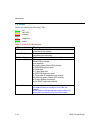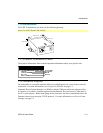
Introduction
1-6
UDS-10 User Guide
1.4 Network Protocols
Note: UDS-10 refers to UDS-10, UDS-10-IAP and UDS-10B except where noted.
The UDS-10 uses TCP/IP protocols for network communication. The supported standards
are: ARP, UDP, TCP, ICMP, Telnet, TFTP, DHCP, AutoIP, and SNMP. For transparent
connections, TCP/IP (binary stream) or Telnet protocols are used. Firmware upgrades can be
made with the TFTP protocol.
The IP (Internet Protocol) protocol defines addressing, routing, and data-block handling over
the network. The TCP (transmission control protocol) assures that no data is lost or
duplicated, and that everything sent into the connection on one side arrives at the target
exactly as it was sent.
For typical datagram applications where devices interact with others without maintaining a
point-to-point connection, UDP datagram is used.
1.4.1 Packing Algorithm
The two available packet algorithms (which define how and when packets are sent to the
network) are software selectable. The standard algorithm is optimized for applications where
UDS-10 is used in a local environment, allowing for very small delays for single characters
while trying to keep the packet count low. The alternate packing algorithm minimizes the
packet count on the network and is especially useful for applications in routed Wide Area
Networks. Various parameters can be set in this mode to economize the serial data stream.
1.4.2 IP Address
Every active device connected to the TCP/IP network must have a unique IP address. This IP
address is used to reference a specific device, for example, to build a connection to UDS-10’s
serial port. See IP Addresses on page 10-1 for a complete description of IP Addressing.
1.4.3 Port Number
A destination IP address and a port number define every TCP connection and every UDP
datagram. A port number is necessary to address an application or a channel on a network
host. The port number can be compared to an extension on a PBX system.
A Telnet application (login to a host with an ASCII terminal) is commonly assigned TCP port
number 23. More than one Telnet connection can be established to one host using the Telnet
port; however, the other peer IP address/port number combinations must be different.
In the UDS-10, a port number can be configured on the channel (port). The UDS-10 uses this
port number for outgoing messages and incoming connections, or UDP datagrams, which are
addressed to its port number. Port 9999 (decimal) is used for remote configuration.


















